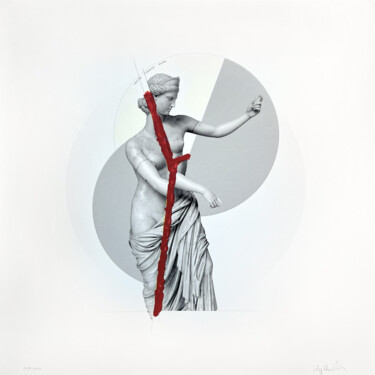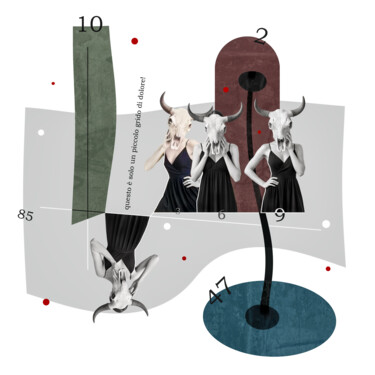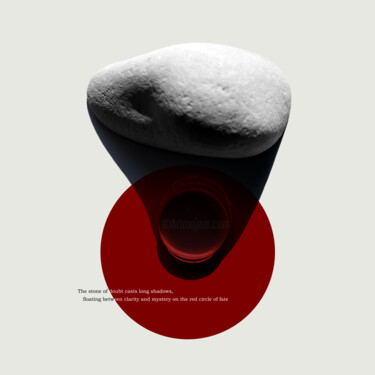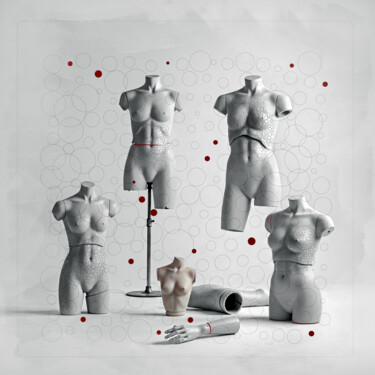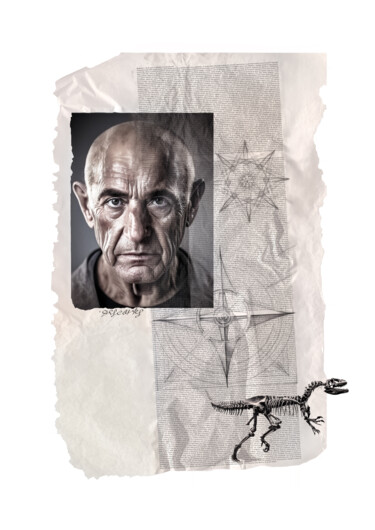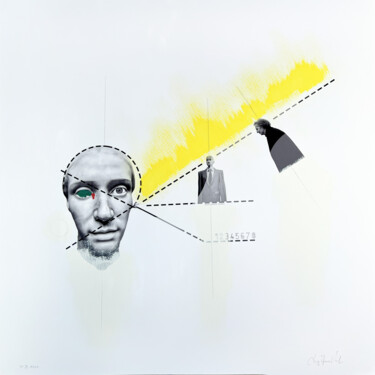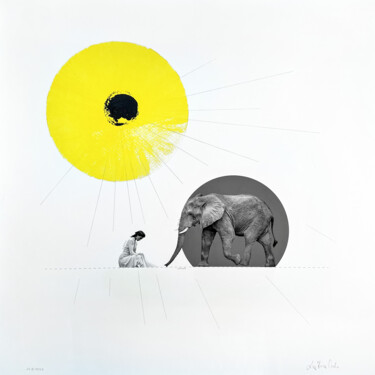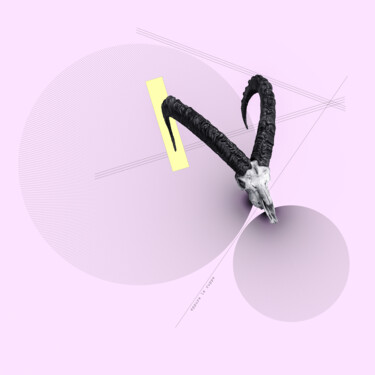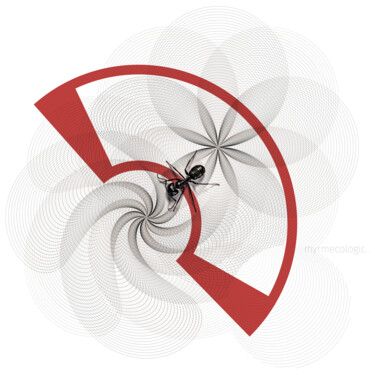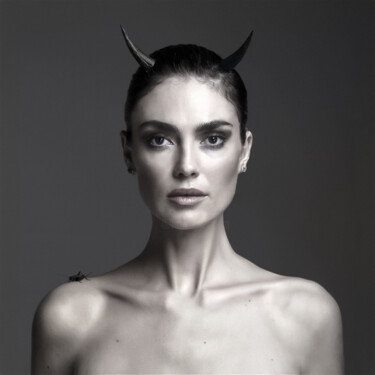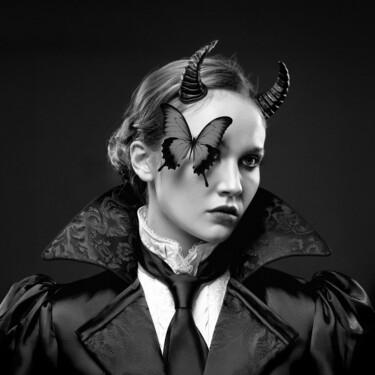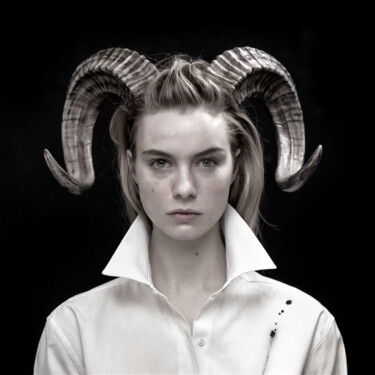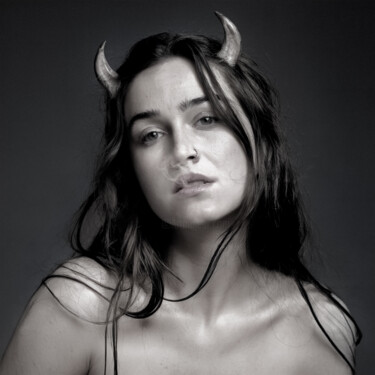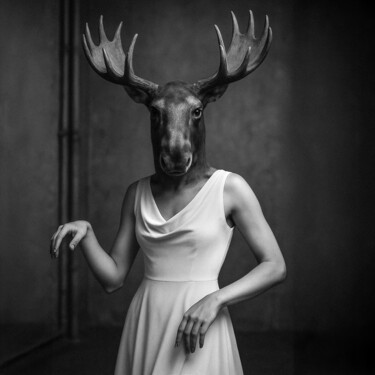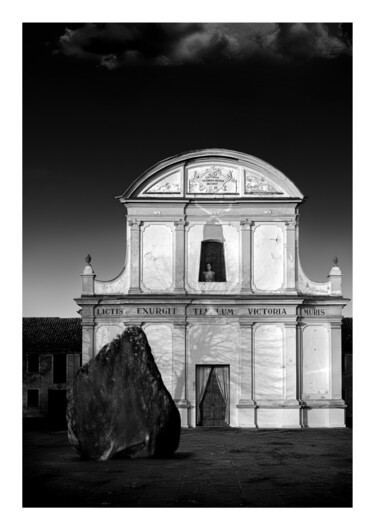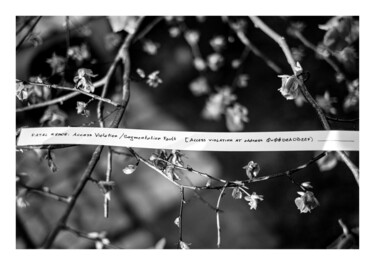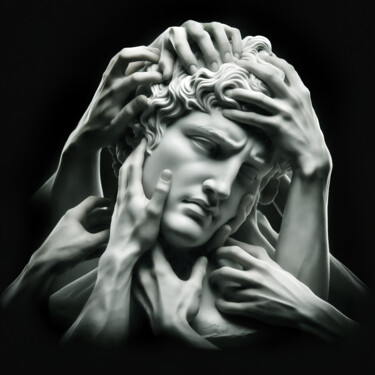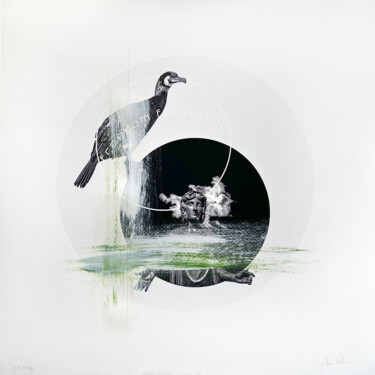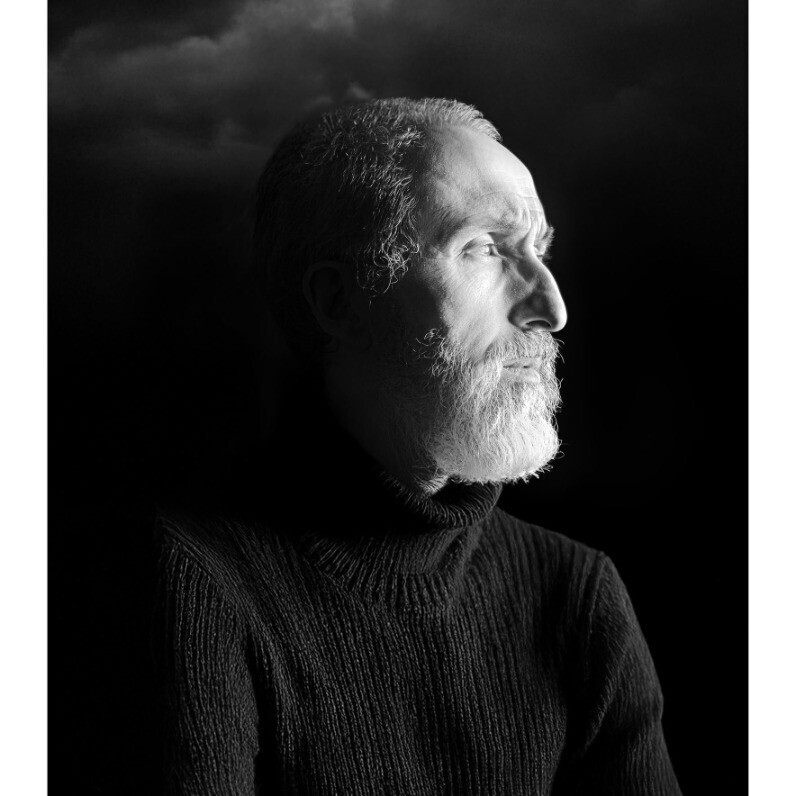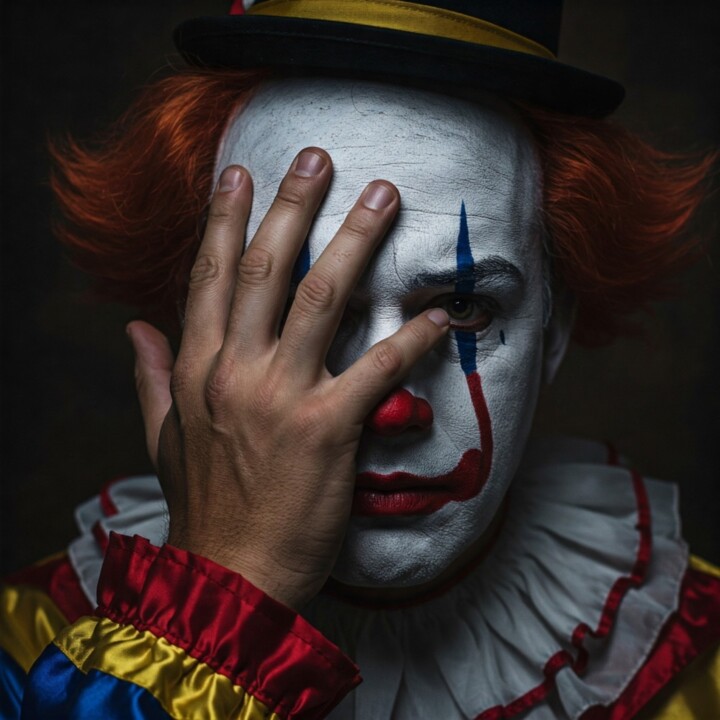Luigi M. Verde 의 모든 작품
Abstract Compositions • 8 작품
모두보기
My artistic practice consciously moves in an area of undecidability, inhabiting that liminal space [...]
My artistic practice consciously moves in an area of undecidability, inhabiting that liminal space where photography, drawing, painting and writing converge in an uninterrupted dialogue. I do not consider this hybrid approach as a simple sum of techniques, but as the affirmation of a poetics that recognizes its generative core in the tension between different languages. Although my works present manual interventions, geometric signs and material stratifications, I consider them fundamentally post-photographs as they maintain a profound connection with the indexical nature of the photographic medium. This media ambiguity is not indecision, but an active semantic strategy.
I am particularly interested in what Jacques Rancière defines as a thoughtful image, an entity that does not simply illustrate a pre-existing thought, but constitutes a magnetic field charged with unresolved tensions, resistant to univocal meanings. The work thus becomes a space of perpetual oscillation between apparently opposite polarities: technological automatism and manual gesture, documentation and creation, material presence and conceptual abstraction.
My creative process reflects this threshold condition: photographic elements are deconstructed and recontextualized, but never completely denied; pictorial interventions assert their materiality without erasing the underlying photographic trace; geometric signs impose a visual order that dialogues with the organic complexity of the captured image; words insinuate themselves between the visual layers, not to explain them but to amplify their ambiguity.
This hybrid practice mirrors our contemporary reality, culturally and technologically fragmented, where images, texts and data constantly mix. I am not interested in resolving this ambiguity, but in consciously inhabiting it in a contemporary landscape, where distinctions between artistic disciplines become increasingly porous.
I am particularly interested in what Jacques Rancière defines as a thoughtful image, an entity that does not simply illustrate a pre-existing thought, but constitutes a magnetic field charged with unresolved tensions, resistant to univocal meanings. The work thus becomes a space of perpetual oscillation between apparently opposite polarities: technological automatism and manual gesture, documentation and creation, material presence and conceptual abstraction.
My creative process reflects this threshold condition: photographic elements are deconstructed and recontextualized, but never completely denied; pictorial interventions assert their materiality without erasing the underlying photographic trace; geometric signs impose a visual order that dialogues with the organic complexity of the captured image; words insinuate themselves between the visual layers, not to explain them but to amplify their ambiguity.
This hybrid practice mirrors our contemporary reality, culturally and technologically fragmented, where images, texts and data constantly mix. I am not interested in resolving this ambiguity, but in consciously inhabiting it in a contemporary landscape, where distinctions between artistic disciplines become increasingly porous.
Digital Art & Drawings • 36 작품
모두보기
Welcome to this collection of digital art and digital drawings, where the cold rigor of geometric shapes [...]
Welcome to this collection of digital art and digital drawings, where the cold rigor of geometric shapes merges with the vibrant warmth of photography, giving life to a visual dialogue that transcends the boundaries between reality and abstraction. Each work is a passage that leads us into a hybrid universe, where the mathematical exactness of lines and angles intertwines with the organic softness of the images captured by the lens. These works are visual alchemies that transform the familiar into something new and surprising. Sharp triangles dance with blurry faces, perfect circles embrace cityscapes, while golden rectangles frame fragments of wild nature. The dance between geometric shapes and photographic visions expresses the desire to project the resulting image into a temporal dimension, marked by tension and balance, which is expressed through a more interior and existential language. So let yourself be transported on this sensorial journey, where logic meets emotion and digital precision blends with the unpredictability of life. These works do not ask to be understood, but to be experienced, like a visual haiku that whispers geometric secrets to the soul.
Chorographie • 34 작품
모두보기
Chorographie is a series of thematic photographs that, like a Greek chorus, resonates in the viewer's [...]
Chorographie is a series of thematic photographs that, like a Greek chorus, resonates in the viewer's soul, entering into dialogue with their spirit to suggest a moral and profound vision of existence. Each single group of images from this metaphysical chorus is almost always born from a feeling, a poem, or some pieces of music that have inspired me, to be transformed into a solo voice that takes on a life of its own. However, it is in the chorality, in singing together with the others, that it finds a "completeness", a more complete sense that comes from being part of a chorus and one with it. Chorality offers a higher vision, a more mature and aware gaze that manages to perceive each part as the essence of the whole. In a certain sense, these photographs are a philosophical manifesto of existence, a living theater where the chorus acts as a bridge between spectator and protagonist, allowing for that transfer of emotions and profound reflections on the human condition. Invention, illusion, memory and even fiction, oblivion, intention, up to the complete suspension of disbelief: to date, photography remains the best visual synthesis for creating reality before even starting to represent it.
Hidden angel, angel of beauty • 27 작품
모두보기
The eternal question, one of those capable of crossing the thoughts of all of us sooner or later, is: [...]
The eternal question, one of those capable of crossing the thoughts of all of us sooner or later, is: "What does the world around us look like?". Although it would be desirable to ask ourselves, and even better to find an answer, to the higher question: "How is our world made?", in the pages of this photographic collection we will only be pleased to explore solely the visual architecture of things, with the aim to discern whether, by dismantling this apparent surface and intertwining it with other emerging elements in our sphere of experience, we can come, at least in part, to see illuminating glimpses of these universal questions, even within the confines of our limited condition. Some angels, or better yet, a more delicate and earthly incarnation of them, with feminine contours, will be the spokespersons of these enveloping enigmas. One more consideration: despite the ideal of beauty that sometimes emerges, even in a spectacular way, from the images in question, on several occasions, a subtle aura of acceptance or even a marked pessimism linked to a peculiar vision of the contemporary world emerges. Whatever interpretation you choose to attribute to this work, it is essential to underline that there are never correct or wrong conclusions, but only new paths to take. At the bottom of a curtain of bitterness, invariably (and always) also stands the profound certainty of something that remains undisturbed, a perpetually practicable path towards happiness and authentic beauty. The last thought goes to some authors such as Borges, Calvino, Rilke, Sciascia who have left an indelible mark on my memory: I could not help but insert some of their famous quotes in the space created by the pairs of images, embracing in particular the hypothesis that each portrait, following in the footsteps of Calvino's "invisible cities", can be transformed into a love letter to photographic art.
These images are part of the artist's book: "Hidden Angel, Angel of Beauty"
These images are part of the artist's book: "Hidden Angel, Angel of Beauty"
"Res" • 16 작품
모두보기
The Latin term "Res" is the thing that exists beyond the name and the face, the substance that persists [...]
The Latin term "Res" is the thing that exists beyond the name and the face, the substance that persists in time, space and chance, the uninterrupted dance between the palpable and the ephemeral. Suspended between the mystery of being and the concreteness of experience is the silent muse of these photographic images. It represents, in a more ontological vision, the fabric of objective reality, but it is also what emerges from consciousness: a deeper ideal or mental vision that offers itself as a subject of contemplation. By weaving a choreography of sensations it opens like a reflection of the complexity between the folds of perception, a constitutive substance of matter itself that merges with the essence of dreams and thoughts, a changing symphony that shapes that ethereal stage between the tangible and the ephemeral. A hymn and an invitation to the wonder of existing.
The groove in which these images are placed is that of an indication of the inexpressible reality, a territory "where I have never been": the photographs are reduced to a sort of pure "inscription" which has no other meaning outside of its mere existence. In these images, once again, language plays an essential role: it acts as a structure of separation where its presence is made only by its becoming silent in front of the visual work. This involves the inevitable manifestation of a "relationship with the lost", this apparent absence of language means that every moment is forgotten, so Res is entrusted with the task of translation so that the visual text becomes unforgettable, a sort of language for the deaf and dumb. The result of these ambiguities is a continuous "retraction": here the intention is not to withdraw or declare the testimony given by the images as false, but rather to "treat again", or to define the meaning in an increasingly clear way, to continue the magic of writing.
The groove in which these images are placed is that of an indication of the inexpressible reality, a territory "where I have never been": the photographs are reduced to a sort of pure "inscription" which has no other meaning outside of its mere existence. In these images, once again, language plays an essential role: it acts as a structure of separation where its presence is made only by its becoming silent in front of the visual work. This involves the inevitable manifestation of a "relationship with the lost", this apparent absence of language means that every moment is forgotten, so Res is entrusted with the task of translation so that the visual text becomes unforgettable, a sort of language for the deaf and dumb. The result of these ambiguities is a continuous "retraction": here the intention is not to withdraw or declare the testimony given by the images as false, but rather to "treat again", or to define the meaning in an increasingly clear way, to continue the magic of writing.
Like a secret breath in light • 9 작품
모두보기
These photographs present themselves as silent enigmas that linger beyond the surface of things. They [...]
These photographs present themselves as silent enigmas that linger beyond the surface of things. They pursue the hidden soul behind the fleeting appearance of the world, that vibrant essence that is concealed from eyes clouded by habit or that eludes the distracted and superficial gaze. To do this, I place obstacles along the path traced by overly stereotypical visions, always ready to veil the secret energy of what I wish to represent. To make these deceptive veils fall, to tear away these illusory masks, has become almost a categorical imperative. Only in this way, through this incessant subtraction, can I glimpse the event in its original purity, like a sudden epiphany, a dazzling revelation that shakes the viewer from the comfortable torpor of routine or from the reassuring dogma of normality. This is why, while remaining faithful to the very essence of photography, working with light and shadow or with the relentless sharpness of the lens, I never deliver to the viewer's gaze predictable copies of reality, but a more unsettling point of view, capable of disorienting the usual coordinates of perception. The image I pursue with tenacity does not reproduce, but generates unexplored worlds. It unveils the unconfessable secret of things with their indecipherable shape, the elusive core of reality as a sudden opening towards a new universe that pulsates within the world itself. In these visions hovers a silence that is dense, profound, almost palpable. They are images situated in the unexplored folds of language, at the extreme edge of the sayable, where words surrender and vision takes over. Despite this incessant search for the invisible, this poignant yearning for the ineffable, my voice always rises to narrate silent losses, deep nostalgias, that lacerating absence that language itself creates in the moment it names and defines, captures and imprisons. Whispers, sediments, distant echoes, are the hushed voices that reach my consciousness, alternating in a discontinuous flow within this small labyrinthine space that I call photography. Something ephemeral and delicate, like a breath suspended in the air, and yet dense with recondite darkness, sometimes even impalpable and elusive like an evanescent ghost.
Retroversi • 18 작품
모두보기
In this series I will discuss the creative process that sparked two works made up of 16 square photographs [...]
In this series I will discuss the creative process that sparked two works made up of 16 square photographs inspired by the dialogue between art and science. We start from the premise that photography is the representation of an idea created through the mediation between our gaze and sensible reality. Conversely, an (un)object that captures our attention can be transformed into an idea to be sealed in an image: I simply reformulated the previous sentence backwards (here comes the first "retroversion"). What would happen now if we tried to follow this process backwards? That is, instead of starting with an object in the physical world, we start from an abstract idea and then arrive at a final artefact. This is the opposite of what we commonly do when taking a photograph: the real object is only subsequently transformed into an idea that we fix on paper or on a screen. Since I wanted to give shape to a curious and restless simulacrum of non-existent female figures, of which only the name and some fleeting and dubious descriptions remain, I will necessarily have to resort to this unusual inversion: I will therefore use an artificial intelligence program to build this sad and narrow memorial of dull, empty, marginal figures, deteriorated by time and vainglory. Subsequently I will place various common objects alongside the printed images in order to recreate a more evocative atmosphere.
For this "artistic experiment" I was inspired by Popper and Eccles' theory of the three worlds. This theory is a philosophical perspective that seeks to explain the complexity of reality in three distinct Worlds:
- The First World refers to the world of objective physical phenomena. It is physical reality, composed of material objects, natural processes and empirically observable events.
- The Second World is the world of mental and subjective phenomena. This world includes the experiences, perceptions, and mental processes that occur within the human mind, including thoughts, emotions, and consciousness.
- The Third World is the world of the products of the human mind, such as language, culture, scientific knowledge, art and social institutions. This world is made up of concepts, ideas, symbols and representations that emerge from human mental activities and influence society and culture.
Popper and Eccles' theory suggests that the three worlds are interconnected and that the complete understanding of reality requires appropriate consideration of each of them. The authors developed such ideas as part of their research into the philosophy of mind and consciousness, seeking to overcome the dichotomy between the objective world of science and the subjective world of human experience.
My goal is thus to create a photographic work of art that passes from World Three to World One, through World Two. Ultimately, if we assume as a hypothesis that art resides in the world of ideas and knowledge, then even the use of new technologies based on generative Artificial Intelligence do not represent any threat to our creative process, but offer us new tools to expand the need to express, in new and increasingly profound ways, our personality.
For this "artistic experiment" I was inspired by Popper and Eccles' theory of the three worlds. This theory is a philosophical perspective that seeks to explain the complexity of reality in three distinct Worlds:
- The First World refers to the world of objective physical phenomena. It is physical reality, composed of material objects, natural processes and empirically observable events.
- The Second World is the world of mental and subjective phenomena. This world includes the experiences, perceptions, and mental processes that occur within the human mind, including thoughts, emotions, and consciousness.
- The Third World is the world of the products of the human mind, such as language, culture, scientific knowledge, art and social institutions. This world is made up of concepts, ideas, symbols and representations that emerge from human mental activities and influence society and culture.
Popper and Eccles' theory suggests that the three worlds are interconnected and that the complete understanding of reality requires appropriate consideration of each of them. The authors developed such ideas as part of their research into the philosophy of mind and consciousness, seeking to overcome the dichotomy between the objective world of science and the subjective world of human experience.
My goal is thus to create a photographic work of art that passes from World Three to World One, through World Two. Ultimately, if we assume as a hypothesis that art resides in the world of ideas and knowledge, then even the use of new technologies based on generative Artificial Intelligence do not represent any threat to our creative process, but offer us new tools to expand the need to express, in new and increasingly profound ways, our personality.
L.O.W. Camera Grammar Exercises • 77 작품
모두보기
As a witty and improvised philosopher, I enthusiastically ventured into this disquisition on the arduous [...]
As a witty and improvised philosopher, I enthusiastically ventured into this disquisition on the arduous question of whether photography can be considered a language or not. The artist, with his ingenious interweaving of images, can undoubtedly create a system of relationships that evokes a sort of visual grammar. On the other hand, the choice to juxtapose certain photographs, to play with light, colours, shots and compositions, suggests a narrative path, an idea, an emotion. In this sense, it could therefore be said that the artist is attempting to build his own language, albeit not formalised, with its peculiarities and its intrinsic coherence. On the other hand, photography differs from language in some aspects: it lacks a universally recognized system of symbols, since its meaning can vary based on the subjective interpretation of the user. Furthermore, images can be ambiguous, polysemous and lend themselves to numerous misunderstandings. Finally, they are strongly dependent on the context, the meaning of an image being influenced by the culture, history and personal experiences of the user. Ultimately, the question of whether photography can be considered a real language remains open. However, the artist's work shows us that images can be used to communicate complex ideas and build evocative narratives thanks to his powerful communicative system. Perhaps, rather than a formalized language, it could be correct to speak of a "language in progress", a fertile ground for experimentation, where images free themselves from the mere representation of reality to take on a role of narrative and psychological introspection. In conclusion, photography is not a language like speech or writing, but it still has the ability to create a powerful dialogue between things.
Visual dialogues • 32 작품
모두보기
This series represents a sort of mental space, an always open passage through which ideas continuously [...]
This series represents a sort of mental space, an always open passage through which ideas continuously transform and adapt to the space and time in which they are exposed. They are also a sort of showcase for looking, with a critical and curious eye, at those different techniques and materials that give shape to original, innovative or experimental works. This open and continually evolving space is therefore a form of research and study, which constantly questions the meaning and value of the work of art. Enjoy your visit!
RADICanto • 23 작품
모두보기
RADICanto reveals an unprecedented perspective between the earth and humanity, underlining how deeply [...]
RADICanto reveals an unprecedented perspective between the earth and humanity, underlining how deeply intertwined our roots are, often more than we can imagine. Here, the human figure takes shape by virtue of the silent work of the roots through a slow construction guided by an ancient song, a sort of primordial energy from which both the earth and the human being have gradually derived their existence.
A contemporary look, however, reveals a curious dynamic: in fact, a contrast seems to emerge with the attacks that the earth suffers, while it defends itself by reclaiming its space again. This operation of apparent "erasure" manifests itself more as a sort of rewriting. We like to imagine that, behind this apparent disagreement, the true contours of coexistence between man and earth are hidden. No longer a relationship of aggression, but a symbiosis, a profound connection that our eyes unfortunately struggle to capture due to the growing distance from the essential things of the world.
This project presents itself as an investigation, an attempt to scrutinize through a gaze less contaminated by prejudice, what could be the ways to return to a principle of cooperation and integration with creation in this era of ever-increasing separation from the fundamental realities of life.
The teeming chaos of these images, a tribute to Pieter Bruegel, will slowly take shape to condense into a large digital collage after a long and meticulous study.
A contemporary look, however, reveals a curious dynamic: in fact, a contrast seems to emerge with the attacks that the earth suffers, while it defends itself by reclaiming its space again. This operation of apparent "erasure" manifests itself more as a sort of rewriting. We like to imagine that, behind this apparent disagreement, the true contours of coexistence between man and earth are hidden. No longer a relationship of aggression, but a symbiosis, a profound connection that our eyes unfortunately struggle to capture due to the growing distance from the essential things of the world.
This project presents itself as an investigation, an attempt to scrutinize through a gaze less contaminated by prejudice, what could be the ways to return to a principle of cooperation and integration with creation in this era of ever-increasing separation from the fundamental realities of life.
The teeming chaos of these images, a tribute to Pieter Bruegel, will slowly take shape to condense into a large digital collage after a long and meticulous study.
판매된 작품 • 4 작품
Loading...




